 At a glance
At a glanceExpert's Rating
Pros
- Roomy 16:10 display
- Thin and light yet rugged
- Stellar keyboard
- Quiet operation
- Booming audio
- Two Thunderbolt 4 ports
Cons
- Webcam limited to 720p
- Display color is a bit cool
Our Verdict
The 9th generation of Lenovo’s flagship ThinkPad gets a 16:10 display for getting work done but otherwise doesn’t stray too far from the successful X1 Carbon script. It’s fantastic.
Best Prices Today: Lenovo ThinkPad X1 Carbon Gen 9
Nearly ten years old, the Lenovo ThinkPad X1 Carbon Gen 9 has grown taller. Lenovo’s flagship ThinkPad is still the same sleek, sturdy corporate ultrabook you may recall, but the manufacturer has ditched the 16:9 display ratio in favor of a 16:10 display that provides more room from top to bottom. The taller display gives you more room to work and requires you to scroll less through lengthy documents and long web pages.
Lenovo also tweaked the display hinge, expanded the touchpad, improved the positioning of the laptop’s speakers, and integrated the fingerprint reader into the power button. Inside, the laptop received the expected Intel update to the chipmaker’s 11th-gen Tiger Lake chips. With its roomier display and other improvements, the ThinkPad X1 Carbon remains a top choice for business execs, even if its webcam is behind the times.
ThinkPad X1 Carbon Gen 9 specifications
Nailing down the pricing for Lenovo’s laptops is a challenge because the company lists inflated prices on its website that are usually then discounted by substantial and fluctuating amounts. The baseline X1 Carbon Gen 9, for example, features a list price of $2,459 but is currently discounted to $999.99. It has an 11th-gen Core i5 CPU, 8GB of RAM, and a 256GB SSD. The manufacturer also lists a handful of preconfigured ThinkPad X1 Carbon Gen 9 models, but our test configuration is not among them. Using the customizable model on Lenovo’s site, we outfitted our test system for $1,799.60. Here are its specs:
[Further reading: Our picks for best PC laptops]
- CPU: Quad-core Intel Core i7-1185G7
- Memory: 16GB
- Graphics: Intel Iris Xe
- Storage: 512GB PCIe NVMe M.2 SSD
- Display: 14-inch, 1920×1200 IPS touch
- Webcam: 720p with physical camera shutter
- Connectivity: Right side: 2 x Thunderbolt 4, USB-A 3.2 Gen 1, HDMI 2.0. Left side: USB-A 3.2 Gen 1, combo audio jack.
- Networking: Wi-Fi 6, Bluetooth 5.0
- Biometrics: Fingerprint reader
- Battery capacity: 57 Watt-hours
- Dimensions: 12.38 x 8.72 x 0.59 inches
- Measured weight: 2.54 pounds (laptop), 0.65 pounds (AC adapter)
- OS: Windows 10 Pro
Our test system features the top-end CPU offered. There are four CPU options, two Intel Core i5 Tiger Lake chips, and two Core i7 Tiger Lake chips — with and without Intel’s vPro. Our review unit is packing the standard 16GB memory allotment, but you can double it to 32GB of RAM. There are three solid-state drives available: 256GB, 512GB, and 1TB. We received the 512GB middle child. We also got the baseline, non-touch, Full HD display, but there are two touchscreen options — one with Lenovo’s Privacy Guard technology and one without — and a non-touch 4K option. Both 4G LTE and 5G mobile broadband are upgrade options; neither was included on our test system. You can configure the X1 Carbon Gen 9 with Windows 11, but our test system is running Windows 10 Pro.
Display gets taller
The ThinkPad X1 Carbon Gen 9 does not stray from the standard ThinkPad script. The matte black chassis will look familiar to anyone who’s been in an office with Lenovo’s business machines. Made from aluminum, carbon fiber, and magnesium, the chassis feels rock solid with little to no flex. Lenovo coats the surfaces with a rubberized paint that provides a smooth yet grippy feel but also makes the laptop a magnet for fingerprints and smudges.

Matt Elliott / IDG
The ThinkPad X1 Carbon has toughness baked in to help it hold up in the field. It has passed a series of MIL-SPEC tests against environmental hazards and extremes. But it’s not a bulky tank of a system. Just the opposite. It weighs a svelte 2.54 pounds. That’s a hair more than the 2.4-pound X1 Carbon Gen 8 version, but the added ounce or so of carrying weight is certainly worth it for the roomier 14-inch 16:10 display. Plus, its 2.5-pound weight is light among premium ultrabooks. For example, the 14-inch HP Envy 14 weighs 3.3 pounds and the 13.3-inch HP DragonFly Max is smaller but is slightly heavier at 2.59 pounds.
The biggest change from the X1 Carbon Gen 8 to Gen 9 is a move from a 14-inch display with a wide 16:9 aspect ratio to a 14-inch display with a taller 16:10 aspect ratio. It may seem like a trivial change, but it amounts to an enormous difference when working. A 16:9 display makes sense for an entertainment-minded laptop because the wide display is a good match for watching movies, but it feels cramped when you are multitasking and juggling a handful of windows. The taller 16:10 display also means you need to scroll less through long documents, spreadsheets, and web pages. For getting work done, a 16:10 display is the way to go.
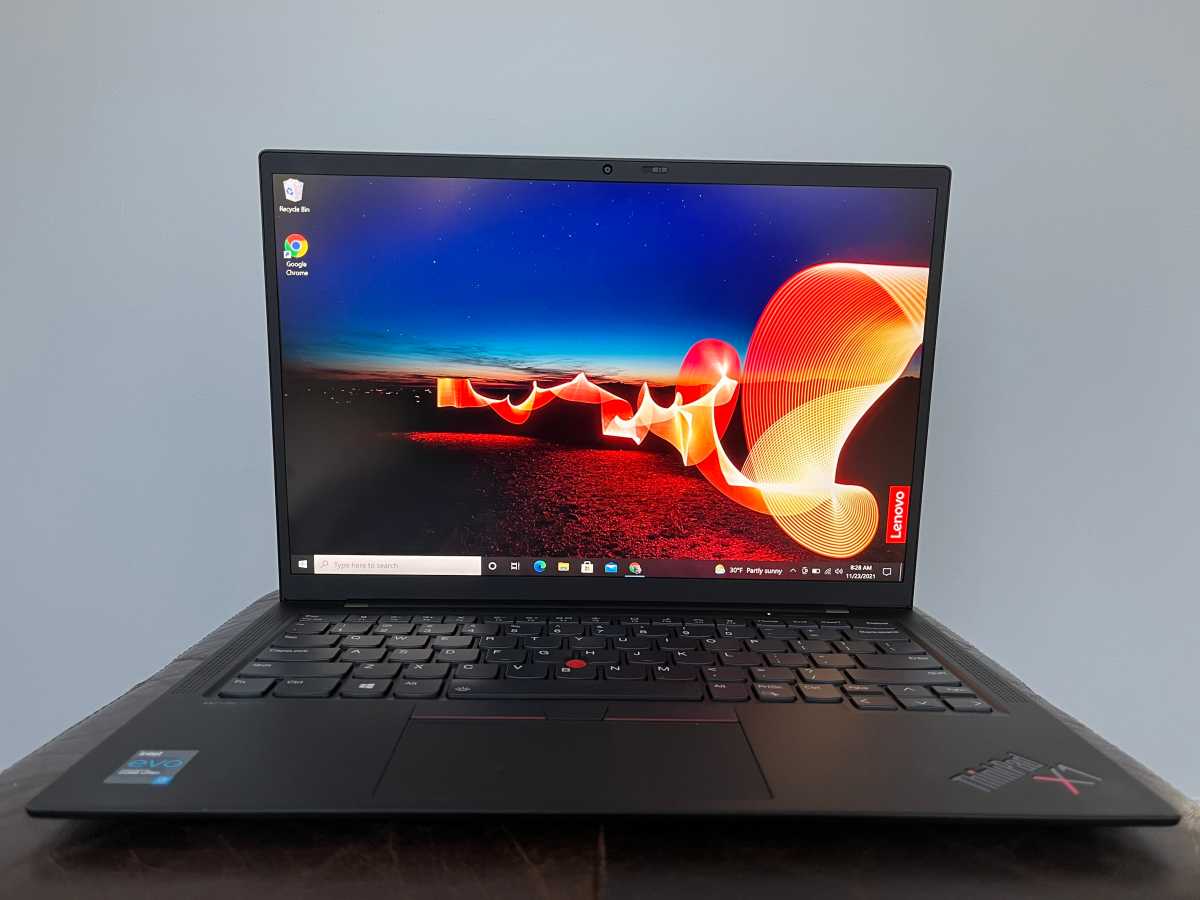
Matt Elliott / IDG
The 14-inch display features a 1920×1280 resolution and boasts a crisp image. The panel is rated for 400 nits of brightness and my measurements confirmed this figure. The brightness is offset some by an overly blue cast that cools its overall impact. I much prefer the warmer screens of the HP Elite Dragonfly Max and HP Pavilion Aero I looked at earlier this year. The X1 Carbon’s contrast was excellent, with bright white and deep blacks, but its colors tended toward the blue end of the spectrum.
There’s also a new display hinge. It’s one long bar that runs nearly the width of the laptop. The hinge provides smooth action while keeping a firm hold on the display’s position. The new design also allows for venting on the back edge of the laptop, which helps with cooling efficiency.
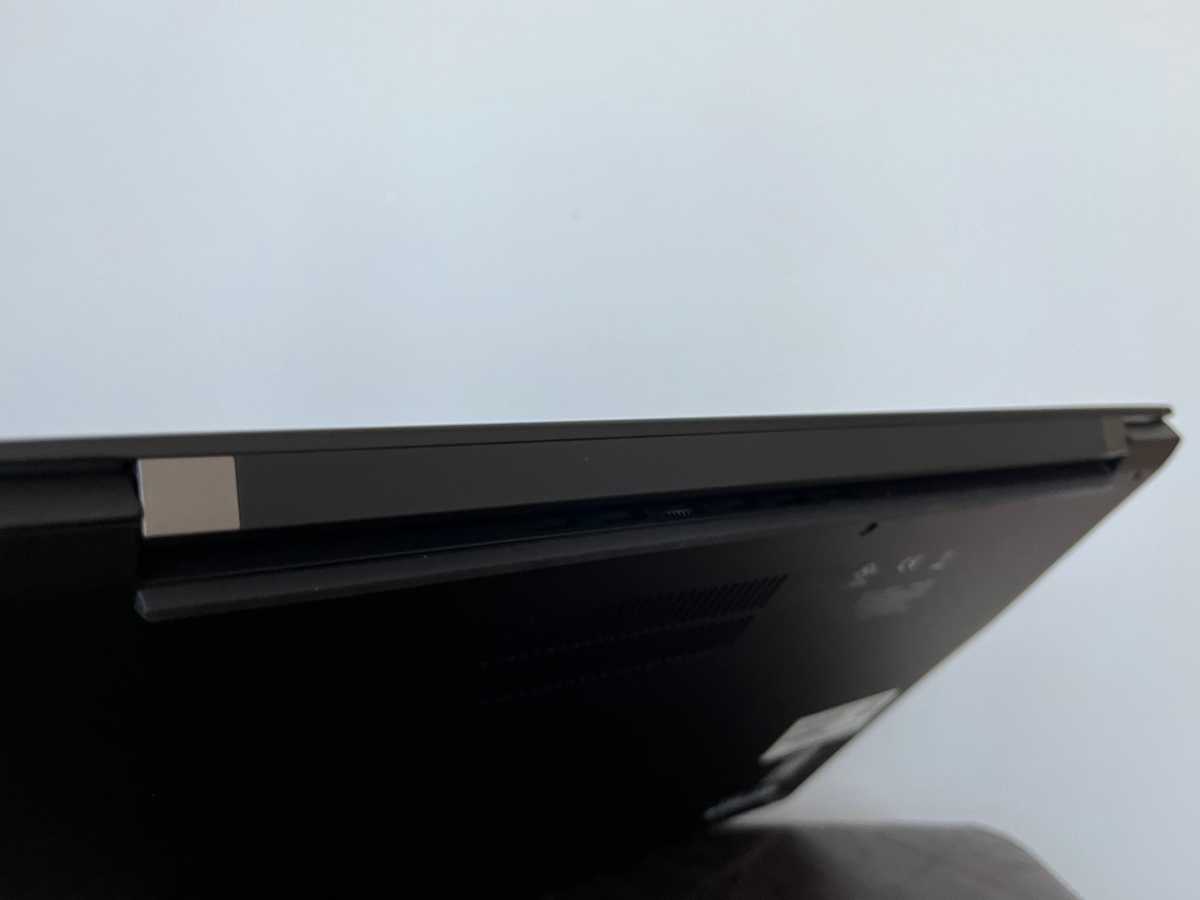
Matt Elliott / IDG
The display may not be geared toward entertainment pursuits, but the speakers can handle fun and games. The laptop features two upward-firing speakers on either side of the keyboard and two woofers on the bottom panel. They produce some of the best laptop audio I’ve heard, with loud, dynamic sound with some bass response. You may not need such sound during the workday, but the X1 Carbon Gen 9 will be of great utility after work for watching Netflix or even listening to music — gasp! — without headphones. I can’t remember the last time I could say that about a laptop I’ve tested.

Matt Elliott / IDG
As impressive as the speakers are, the webcam is decidedly mediocre. At a time when 1080p cameras are becoming more common, it’s disappointing to see Lenovo stick with a standard 720 cam on its flagship laptop. If Zoom meetings are a big part of your workday, then a 1080p camera can make you much clearer to colleagues and clients. The X1 Carbon’s 720p cam produces a well-balanced image with accurate colors, but it’s grainy. A 1080p upgrade ought to be on the wish list for the X1 Carbon Gen 10 if not already at least an upgrade option for the Gen 9. Even a 1440p webcam isn’t too much to ask for — that’s what you get with HP’s Elite Dragonfly Max. The X1 Carbon’s only camera upgrade is a 720p camera with IR, which allows you to use facial recognition for logins. In the plus column for the X1 Carbon’s webam is the presence of a physical privacy cover.
The X1 Carbon Gen 9 is not without biometrics. A fingerprint reader comes standard. It was previously located next to the touchpad and has been relocated on the Gen 9 and integrated into the power button above the keyboard.
Same great ThinkPad keyboard
The main constant across all ThinkPads is the excellent keyboard and such excellence shows up here. The keys feel snappy and are quiet when mashed and offer just the right amount of travel. There are no annoyingly shortened keys to interrupt your typing flow, but like all ThinkPads, the Function and Control keys are flip-flopped, which may take a bit of getting used to. Two-level backlighting is on board, as is the red pointing stick in the middle of the keyboard.

Matt Elliott / IDG
The pointing stick survives and makes it to another generation of ThinkPad, probably because there would be riots in the streets by the ThinkPad faithful if Lenovo ditched this legacy input device. The dedicated mouse buttons for the pointing stick sit between the spacebar and touchpad, and they are less intrusive than past efforts. Instead of being raised with bold red striping, they sit flusher with more subtle red stripes on their front edges.
Lenovo states that the X1 Carbon Gen 9’s touchpad is wider than the Gen 8’s and I must believe them. It doesn’t appear to be bigger than the average touchpad, but it’s roomy enough that I didn’t feel cramped with swiping and pinching and two-finger scrolling.
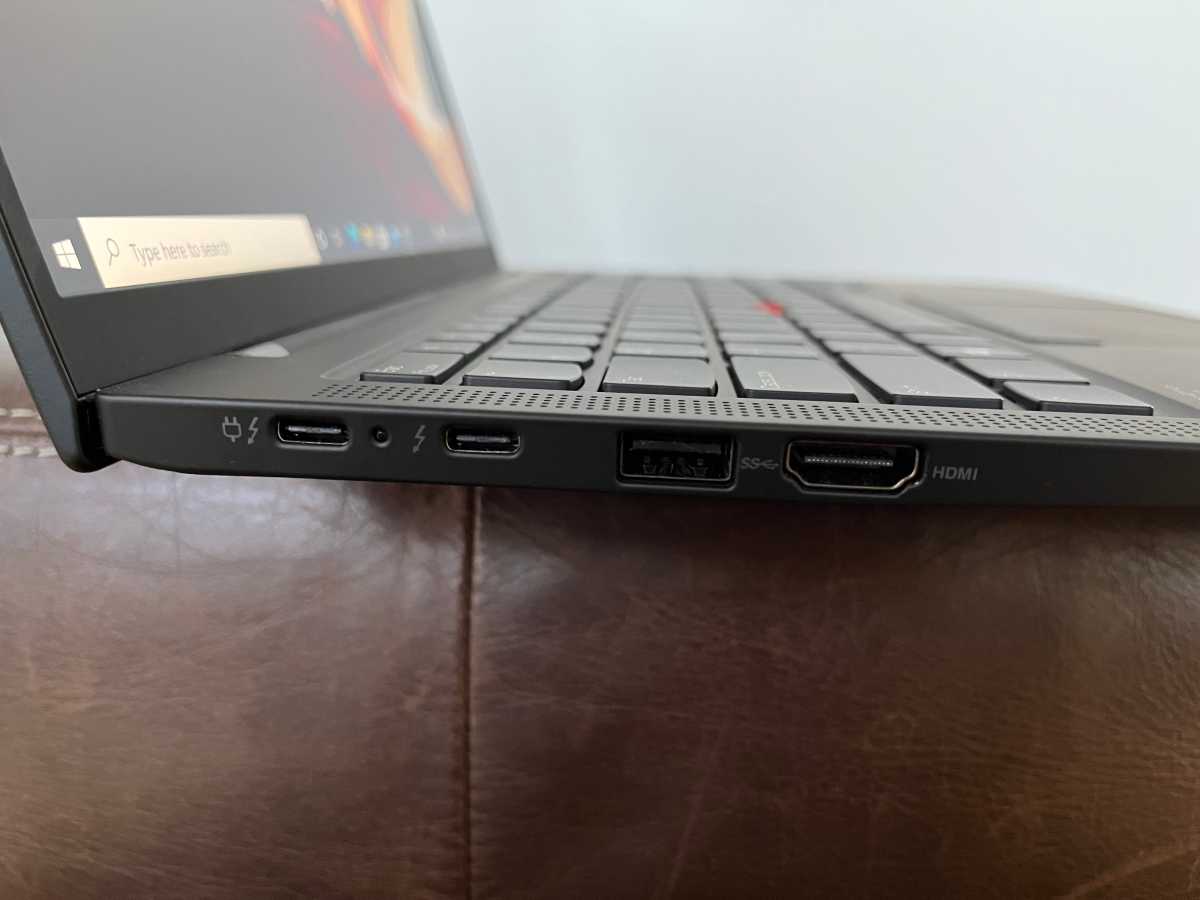
Matt Elliott / IDG
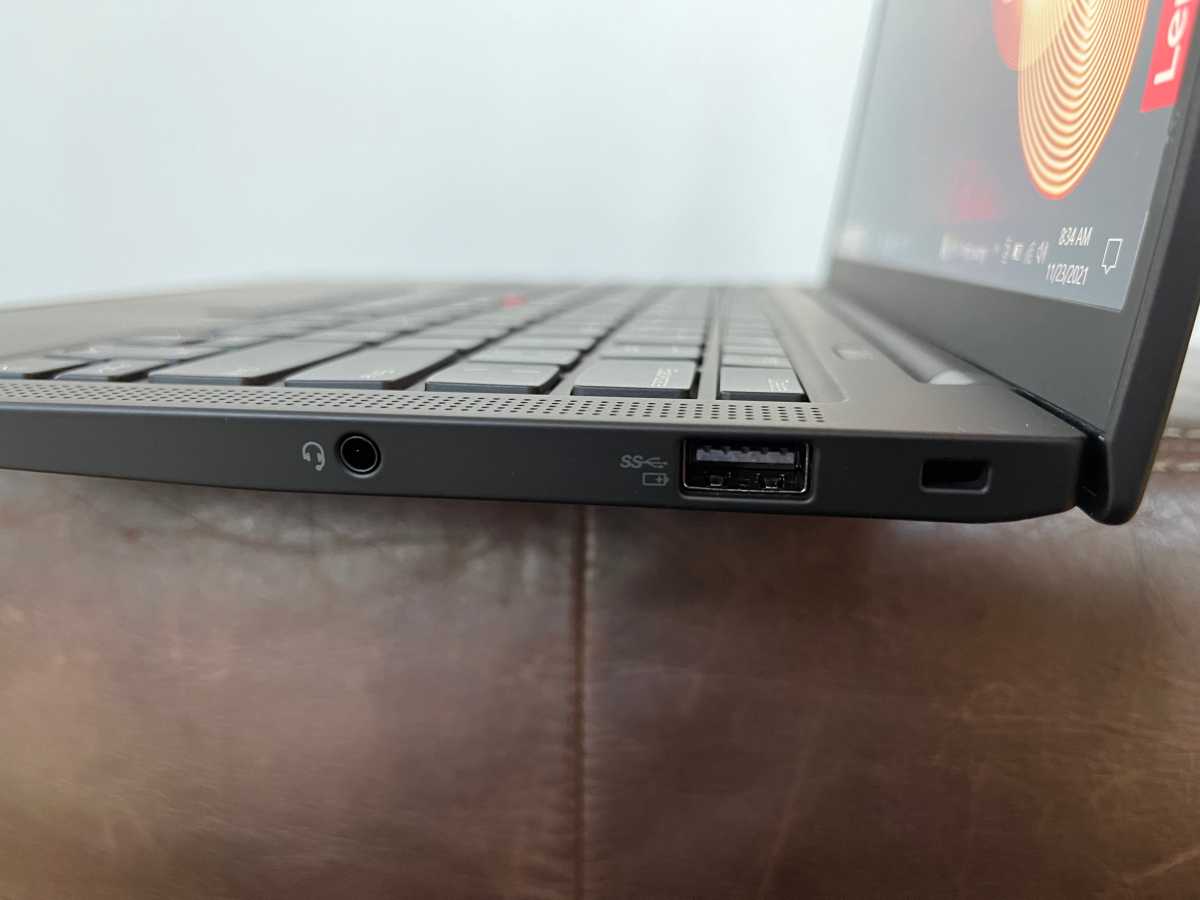
Matt Elliott / IDG
A pair of Thunderbolt 4 ports are the highlights of the X1 Carbon Gen 9’s connectivity. You also get a pair of USB-A 3.2 Gen 1 ports, which means you won’t need to carry a USB dongle. The biggest omission is an Ethernet jack, which means you will need to carry around an Ethernet adapter if you want to connect to a wired network. The laptop supports WiFi 6, the latest wireless networking standard.
ThinkPad X1 Carbon Gen 9 performance
Our ThinkPad X1 Carbon Gen 9 features the quad-core Core i7-1185G7 from Intel’s 11th-gen Tiger Lake family of processors. It also supplies 16GB of RAM and integrated Intel Iris Xe graphics. There’s no option for a GPU upgrade, making the X1 Carbon a better fit for busy execs than creative pros. We compared it against HP’s premium Elite Dragonfly Max, which packs the same Core i7-1185G7 CPU. We also included the Razer Book 13 and the Dell XPS 13 2-in-1 9310, both of which use a Core i7-1165G7 chip. We also compared it to the Core i7-1160G& chip inside the 13-inch ThinkPad X1 Nano. Each of these Core i7 parts is a quad-core processor with eight processing threads. Rounding out the charts is the HP Pavilion Aero 13 and its AMD’s eight-core Ryzen 7 5800U CPU. All of these laptops have integrated graphics.
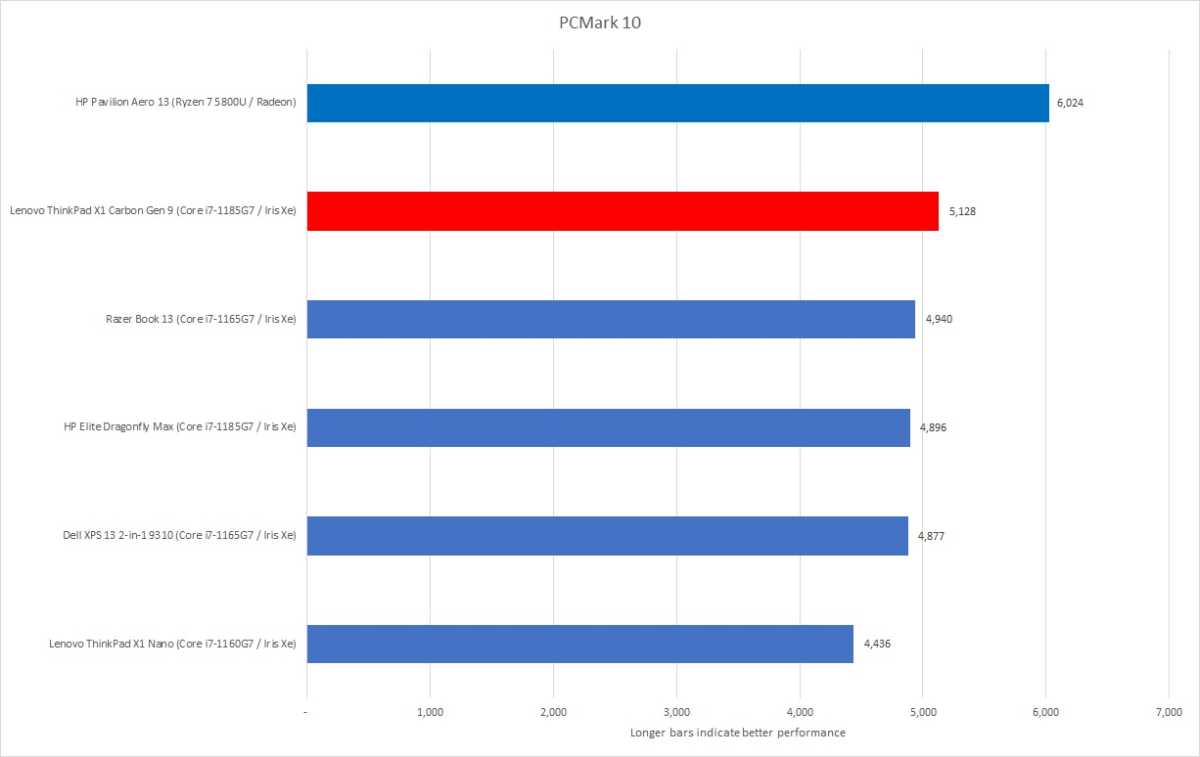
Matt Elliott / IDG
Our first benchmark is PCMark 10, which measures performance on everyday computing work including office productivity tasks, web browsing, and video chats. The X1 Carbon finished first among the Intel-based systems here but well behind the pace set by the AMD-based HP Pavilion Aero. Still, a score above 5,000 indicates that the X1 Carbon is well equipped to run Office and other productivity apps and able to manage a variety of multitasking scenarios.
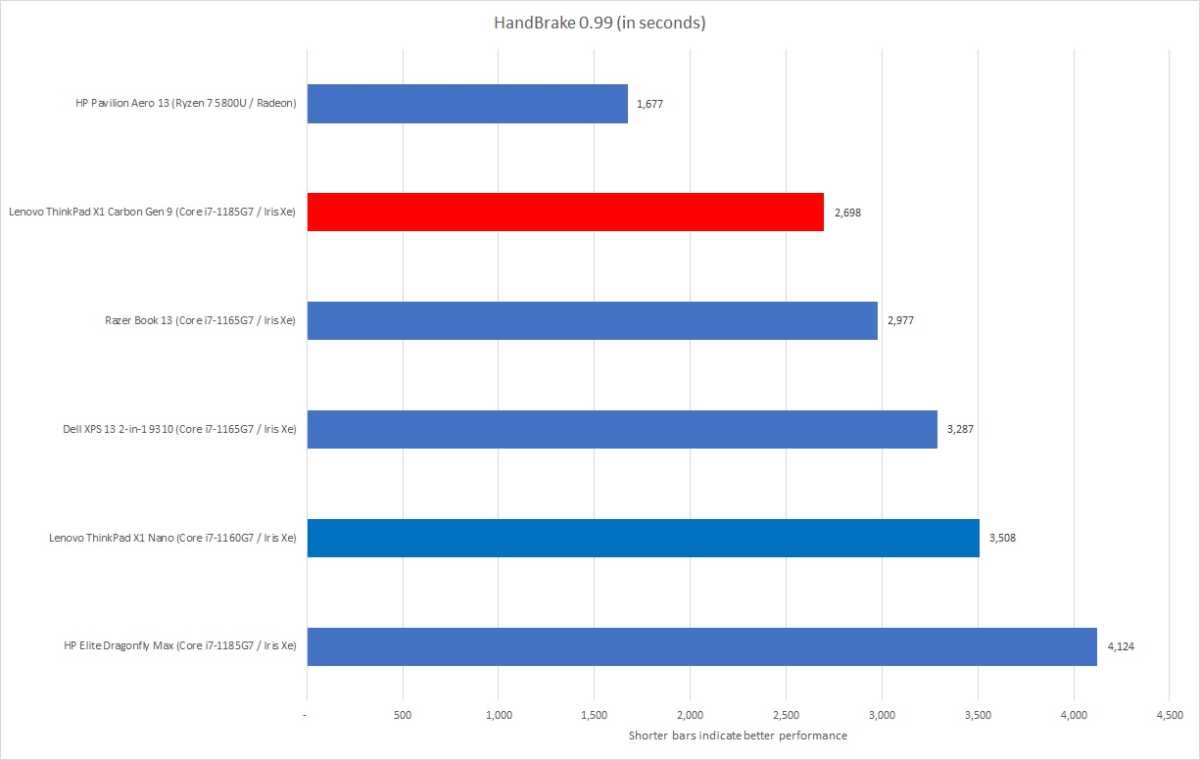
Matt Elliott / IDG
The X1 Carbon also finished behind the HP Pavilion Aero and ahead of the other Intel machines on our HandBrake test, which involves encoding a large 30GB video file. It can perform some media editing, but more processing cores and threads would make quicker work of such a task.
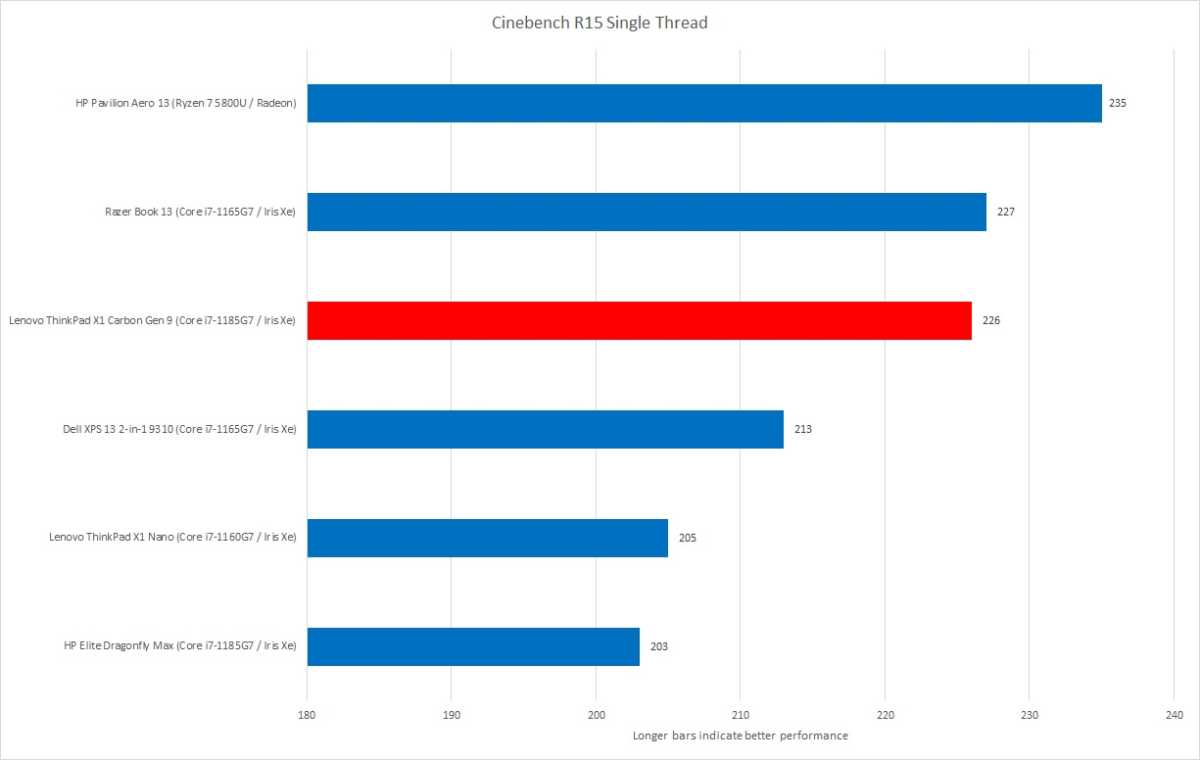
Matt Elliott / IDG
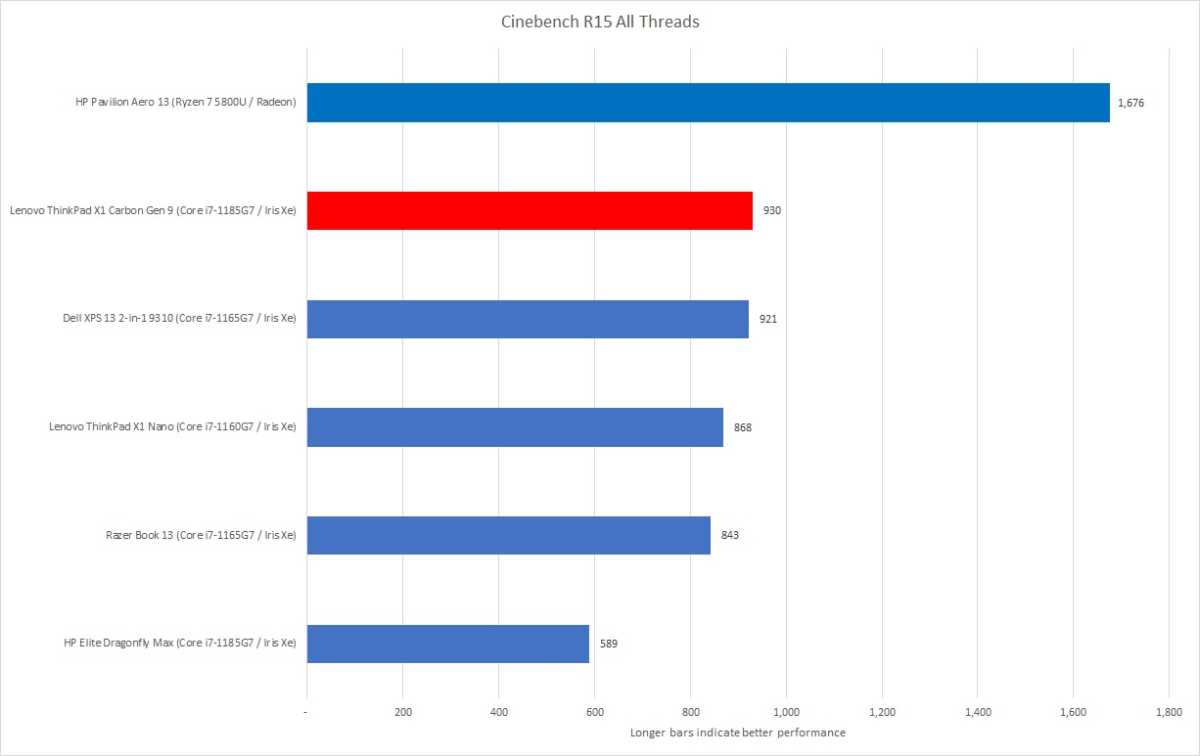
Matt Elliott / IDG
If our HandBrake test is a marathon, then Cinebench is a sprint. This test renders a complex 2D scene over a brief period of time. Again, the X1 Carbon proved itself capable, but more cores and threads shorten the time spent rendering.

Matt Elliott / IDG
Don’t let its first place showing on our 3DMark test fool you. None of these laptops, all of which rely on integrated graphics, posted a score indicating much in the way of 3D graphics capacity. Although Intel’s Iris Xe integrated graphics is surprisingly good, as our tests have shown, we have yet to reach the era where an integrated GPU will catch the attention of gamers.
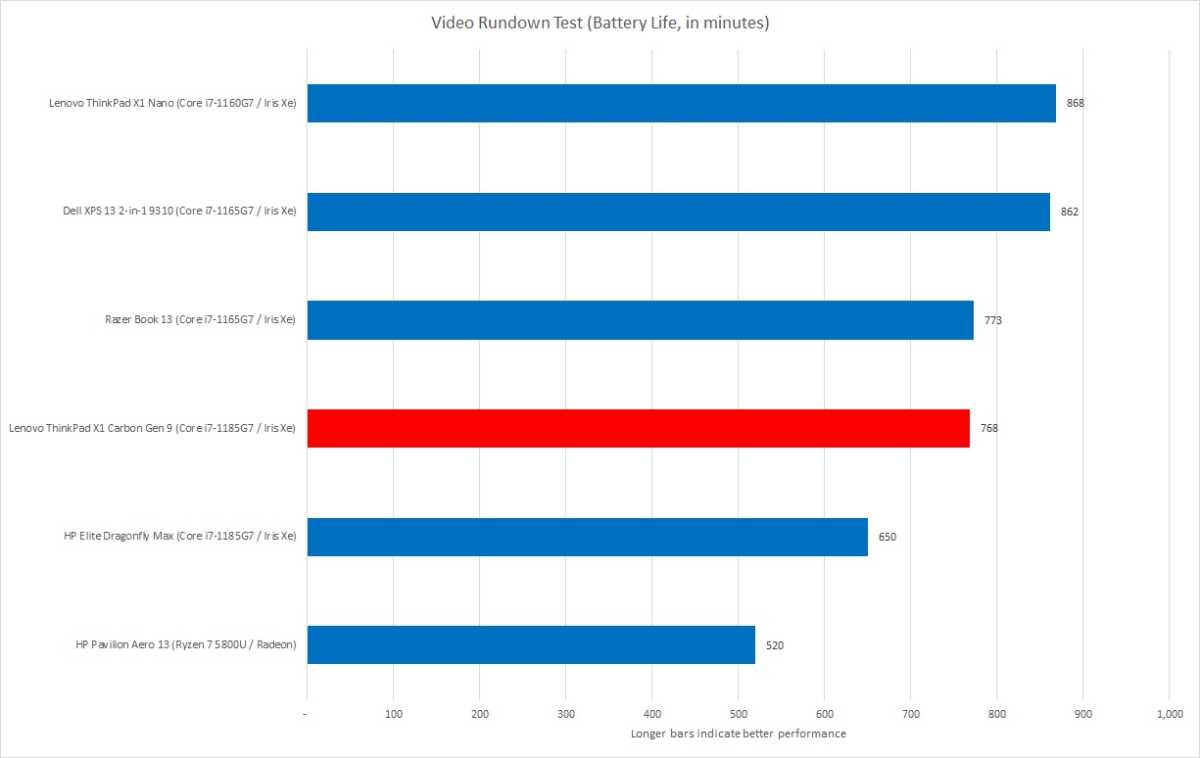
Matt Elliott / IDG
To test a laptop’s battery life, we loop a 4K video using Windows 10’s Movies & TV app, with the laptop set to Airplane mode and earbuds plugged in. We set the screen brightness at a relatively bright 250 nits to 260 nits, which is a good brightness for watching a movie in an office with the lights on. The X1 Carbon’s 4-cell, 57 Whr battery lasted nearly 13 hours on our battery-drain test, which is competitive and will get you through the longest of workdays. That said, it’s still roughly 1.5 hours less than the runtime we saw from the Dell XPS 13 2-in-1.
The display height is perfect for getting work done
Lenovo made some significant changes to the ThinkPad X1 Carbon Gen 9 while also knowing when and where to leave the good bits alone. The new 16:10 display gives you more room to work with and barely adds any additional weight. The new display hinge is smooth and steady and allows for rear cooling vents that keep the laptop quiet and cool. And the new speakers produce shockingly good laptop audio. With these changes, you still get the ThinkPad keyboard that remains the standard against which all Windows laptops are measured. And the X1 Carbon’s sleek yet rugged case makes it eminently portable while also being able to withstand the abuses heaped upon it during daily business travel. Really, our only gripe is the slightly cool display and mediocre webcam. In this era of Zoom meetings, Lenovo needs to upgrade it to a 1080p or 1440p resolution or at least offer a resolution higher than 720p as an upgrade option.
Minor nitpicks aside, it’s a great laptop for business professionals. The battery life will last you throughout the work day and the keyboard is both quiet and soft, which is perfect if you’re in a meeting. It’s fantastic for travel, too. The laptop is super rugged, as it’s built with high quality materials, but it’s not overly bulky or heavy. That makes it tough enough to withstand any accidental bumps but also light enough to take with you on an airplane. If you’re looking for a laptop that can travel well and has decent performance, this is the one to pick.



